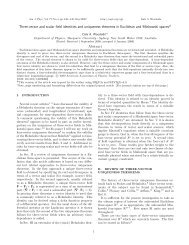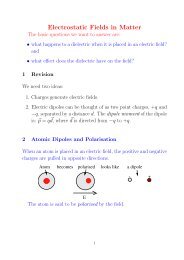Chapter 8 Vector Spaces in Quantum Mechanics
Chapter 8 Vector Spaces in Quantum Mechanics
Chapter 8 Vector Spaces in Quantum Mechanics
You also want an ePaper? Increase the reach of your titles
YUMPU automatically turns print PDFs into web optimized ePapers that Google loves.
<strong>Chapter</strong> 8 <strong>Vector</strong> <strong>Spaces</strong> <strong>in</strong> <strong>Quantum</strong> <strong>Mechanics</strong> 80will show that there is a perfect analogy between Eqs. (7.43) and (7.44) and correspond<strong>in</strong>grelationships for ord<strong>in</strong>ary (complex) vectors. Return<strong>in</strong>g to the Stern-Gerlach examplediscussed <strong>in</strong> the preced<strong>in</strong>g <strong>Chapter</strong> we obta<strong>in</strong>ed there an expression Eq. (7.44)|S 〉 = |+〉〈+|S 〉 + |−〉〈−|S 〉.for the state of a sp<strong>in</strong> half atom expressed <strong>in</strong> terms of the states |±〉, which are statesfor which the atom has a z component of sp<strong>in</strong> equal to ± 1 , and 〈±|S 〉 are probability2amplitudes (complex numbers) whose magnitude <strong>in</strong> some sense tells us ‘how much’ ofthe states |±〉 are to be found <strong>in</strong> the state |S 〉. This result was obta<strong>in</strong>ed by ‘cancell<strong>in</strong>g’ thecommon factor ‘〈S ′ |’ from the result〈S ′ |S 〉 = 〈S ′ |+〉〈+|S 〉 + 〈S ′ |−〉〈−|S 〉.What we should bear <strong>in</strong> m<strong>in</strong>d here is that we can recover this relationship between probabilityamplitudes by re<strong>in</strong>troduc<strong>in</strong>g ‘〈S ′ |’ <strong>in</strong>to Eq. (7.44) for any chosen f<strong>in</strong>al state, yield<strong>in</strong>gan expression for the probability amplitudes as needed. Thus, as has been said before,Eq. (7.44) effectively represents a ‘template’ <strong>in</strong>to which we <strong>in</strong>sert the appropriate <strong>in</strong>formation<strong>in</strong> order to recover the required probability amplitudes. We can also note that thereis noth<strong>in</strong>g sacred about choos<strong>in</strong>g to cancel the the common factor |S 〉 – we could equallyas well cancel the factor |S 〉, yield<strong>in</strong>g〈S ′ | = 〈S ′ |+〉〈+| + 〈S ′ |−〉〈−|. (8.11)Hav<strong>in</strong>g carried out this cancellation procedure, what has reappeared is the state of a quantumsystem i.e. |S 〉 which was <strong>in</strong>troduced earlier <strong>in</strong> a different context, specifically asbe<strong>in</strong>g noth<strong>in</strong>g more than a way of writ<strong>in</strong>g down all that we knew about the state of aquantum system. There, the notation had no mathematical significance, but <strong>in</strong> the manner<strong>in</strong> which it appears here, it seems to have acquired a mathematical mean<strong>in</strong>g of some k<strong>in</strong>d.The aim is to see what this mean<strong>in</strong>g might be, and <strong>in</strong> do<strong>in</strong>g so, we will show that theexpression for |S 〉 has many of the properties that we associate with express<strong>in</strong>g a vectoras a sum of its components.We beg<strong>in</strong> by consider<strong>in</strong>g the probability amplitudes 〈S ′ |S 〉 themselves. These are complexnumbers <strong>in</strong> general for arbitrary sp<strong>in</strong> directions, (but they were real <strong>in</strong> the particularStern-Gerlach example used above), such that their modulus squared |〈S ′ |S 〉| 2 is the probabilityP(S ′ |S ) of observ<strong>in</strong>g the sp<strong>in</strong> to be <strong>in</strong> the state |S ′ 〉 given that it was <strong>in</strong> the state |S 〉.In particular, 〈S |S 〉 is the probability amplitude of observ<strong>in</strong>g the sp<strong>in</strong> to be <strong>in</strong> the state |S 〉given that it was <strong>in</strong> the state |S 〉. This will have to be unity, i.e. P(S |S ) = |〈S |S 〉| 2 = 1.Thus we can conclude that〈S |S 〉 = e iη (8.12)where η is an arbitrary phase. It turns out that this phase always cancels out <strong>in</strong> anycalculation of observable quantities, so it is conventionally set to zero, and hence〈S |S 〉 = 1. (8.13)The state |S 〉 is said to be normalized to unity. As a particular case, this last result impliesthat〈+|+〉 = 1. (8.14)
















